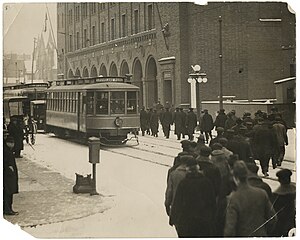| 1917 Twin Cities streetcar strike | |||
|---|---|---|---|
| Part of streetcar strikes in the United States | |||
 | |||
| Date | October 6–9, 1917 (Initial strike, 3 days) November 25, 1917 (lockout) December 13, 1917 (General strike) | ||
| Location | Minneapolis–Saint Paul, Minnesota, United States | ||
| Caused by | Low wages and poor working conditions | ||
| Goals |
| ||
| Methods | |||
| Resulted in | Company fires several unionized employees, resists union demands, succeeds in breaking the strike | ||
| Parties | |||
| |||
| Number | |||
| |||
The 1917 Twin Cities streetcar strike was a labor strike involving streetcar workers for the Twin City Rapid Transit Company (TCRT) in the Minneapolis–Saint Paul metropolitan area of the U.S. state of Minnesota, popularly known as the Twin Cities. The initial strike lasted from October 6 to 9, 1917, though the broader labor dispute between the streetcar workers and the company lasted for several months afterwards and included a lockout, a sympathetic general strike, and months of litigation before ending in failure for the strikers.
The labor dispute began in August 1917, when streetcar workers began to openly discuss their grievances regarding their poor working conditions and low pay. In September, the workers met with Horace Lowry, the president of the company, to discuss possible wage increases and changes to working conditions, though Lowry resisted both. As a result, the workers organized with the International Amalgamated Association of Street and Electric Railway Employees, which established two local unions in the Twin Cities. Lowry responded by firing several union employees and offering remaining employees a ten percent wage increase, though they rejected the offer because it would not have included the rehiring of those employees. Fearing a possible labor strike, the Civic and Commerce Association, Minneapolis's employers' organization, mobilized the Civilian Auxiliary, an auxiliary group they had formed at the beginning of the United States's entry into World War I earlier that year.
On October 6, the streetcar workers went on strike, which went relatively peacefully in Minneapolis, but became violent in nearby Saint Paul, where a mob of about 3,000 people roamed the streets and committed acts of violence and property damage against both TCRT and non-TCRT owned property. The violence became so bad that Minnesota Governor Joseph A. A. Burnquist mobilized the state's home guard. On October 9, the Minnesota Commission of Public Safety (MCPS, a watchdog organization formed by the state government during the war) became involved, bringing an end to the strike as they mandated that the company institute improved working conditions and pay increases while they reviewed the terminations on a case-by-case basis. While the union claimed a partial victory with the strike, the company soon after began to plan ways to damage the union. They created a company union whose members often engaged in confrontations with amalgamated union employees, prompting the streetcar union to request the MCPS to intervene again. The MCPS organized a committee to address both sides' grievances and ultimately found in favor of the company, ruling that the union could not solicit or propagandize on company property, such as with wearing buttons advocating for the union. Taking advantage of the ruling, the company committed a lockout of about 800 union employees on November 25, further inflaming tensions. On December 2, a pro-labor rally at Saint Paul's Rice Park in support of the streetcar workers turned violent and resulted in a mob of about 2,500 damaging property in the city, and around the same time, labor leaders in the Twin Cities announced plans for a general strike. This general strike, which involved about 10,000 workers, was held on December 13 and was called off after less than four hours when it was announced that federal mediators would become involved in the streetcar labor dispute. The mediators found in favor of the union, but the company refused to obey their recommendations, which the mediators were powerless to enforce, and the union, which had previously agreed to a no-strike clause, was powerless to protest. After several months of litigation stretching into 1918, the labor dispute ended in failure for the union.
Following World War I, the Civilian Auxiliary and the MCPS would be disbanded. It would take until 1934 for employees of the TCRT to become unionized under the banner of the Amalgamated Transit Workers Union. The company would continue operations until 1970, when its assets were absorbed by Metro Transit. Discussing the strike in a 2001 book, historian Mary Lethert Wingerd said, "I think it’s one of the most important events in the history of Minnesota, and one of the least recognized". Wingerd states that the strike exposed the federal government's limited power in addressing local labor disputes and resulted in later changes at the national level to address this. Additionally, the strike, which was supported by the Nonpartisan League, resulted in closer collaboration between organized labor and agricultural interests, contributing to the formation of the Minnesota Farmer–Labor Party the following year.
